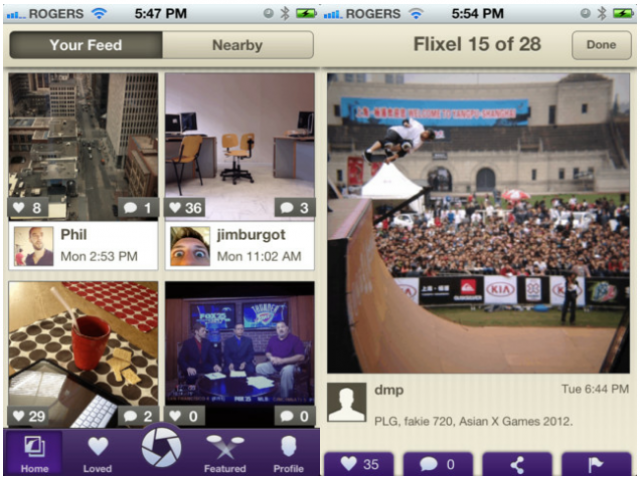
App permanence is possibly the most complicated aspect of success: how does a developer ensure that users will want to come back, day after day? What does it take to create truly memorable experiences without alienating the user? And what the heck is a living photo?
Phil LeBlanc thinks he knows the answers to these timeless questions, and in regards to the last one, a living photo is one that combines the best of smartphone photography: immediacy, movement, and timelessness.
I had a change to talk to LeBlanc about his newest creation, Flixel for iPhone. It’s like Instagram but better. It’s a small app with big promises: the ability to selectively choose the movement in two seconds of video capture. On paper it’s simple, but some of the results are extraordinary.
Me: Where did Flixel come from? What gave you the idea of a “living photos” app?
LeBlanc: We had been looking to get into the app space for some time. We were brainstorming all sorts of ideas ranging from fashion to wellness apps and then one day, completely by accident, I stumbled upon the works of Kevin Burg and Jamie Beck via our interests for cinema and photography. [Immediately] I felt like they had birthed a truly original perspective.
As a result of this inspiration, I began exploring ways to translate this innovation into the mobile space. Soon after, Flixel Photos kicked off with co-founder Mark Homza and the aid of Toronto’s Endloop Mobile. Keep in mind that, at the time of our discovery, there were no “cinemagraph” apps available on the market.
Me: Where did your entrepreneurial spirit come from?
L: My initial contact with tech came about the last project I was involved in: a health and wellness consultancy company in New Brunswick (HOB Inc.) I had co-founded with Mark Homza (Flixel’s co-founder and CMO). There we worked closely with a development shop to architect an innovative user portal for our clients (Fairmont Raffles Hotels, Atlantic Lotto) to provide their employees with reports/updates on their health metrics and overall fitness progress. This gave us an understanding of the potential scalability and reach that social technology platforms and products possess (when properly executed). From then on, it was a natural transition towards tech.
Me: How did you turn a complicated idea like mobile cinemagraphics into the intuitive interface found in Flixel?
L: In terms of UI, from a functional perspective our first goal was turning a complex process into something easy and fun. Discovery was our second intent: making it easy for users to find eachothers’ work. Encouraging participation and sharing were also key elements.
From a visual stand point, an interface that was clean, classy, and distinctive was the mandate. I was quite pleased with Purple as a fitting accent colour. The fact that purple is a red/blue hybrid colour was the perfect fit for our photo/video hybrid app!
Me: What do you think was the breakthrough feature for Flixel, something that would set it apart from imitators?
L: Our biggest breakthrough came about with the introduction of the “live-painting animation.” Early prototypes involved painting on top of the area to be animated, and then sending it to be processed to see how it looked. A lot of back and forth steps were needed, making the creation flow quite unintuitive. It also took all the fun out of the creative process. Going from that to the instant gratification of live-painted animation was a major benefit for Flixographers of all levels and remains, in my humble opinion, a huge competitive advantage for Flixel.
Me: Can you tell me some usage statistics for Flixel?
L: Flixel cracked 100k+ users in less than four weeks after launching. We reached top 10 rankings in the photo/video category in 30+ countries at different times (Canada, USA, etc.). Our average daily/weekly/monthly user engagement is also above the photography app benchmark.
Me: How do you plan to monetize Flixel? Do you plan on raising another round of venture capital funds in the near future?
L: We are assessing a diverse range of offers from VCs and Angels at the moment.
Regarding monetization, we are looking at exploring the option of implementing more paying in-app features as to better diversify the cinemagraph creation experience. A potential Flixel Pro version is in the works as well, and we are customizing the app for the iPad.
We have no release date as of yet for Android but this remains high on our priority list.
M: What’s next for Flixel in the immediate future?
L: We are currently focused on further enhancing our tech in the coming days/weeks. Long term: to become the easiest and most engaging way to create and share beautiful living photos.
If you haven’t yet tried Flixel on your iPhone, I encourage you to check it out. For some amazing examples of cinemagraphs without installing the app, search for #flixel on Twitter.
MobileSyrup may earn a commission from purchases made via our links, which helps fund the journalism we provide free on our website. These links do not influence our editorial content. Support us here.


